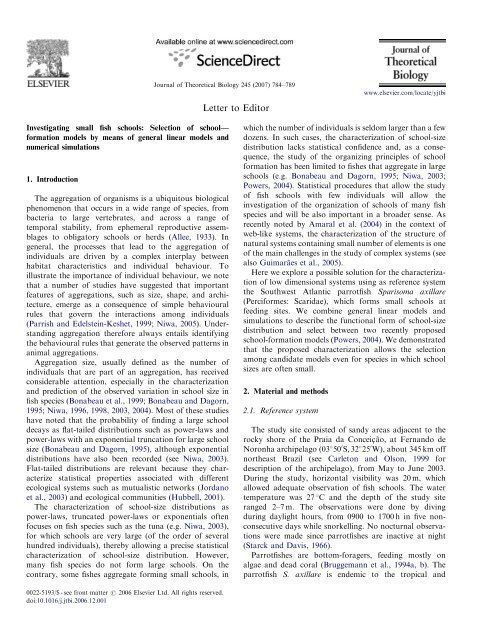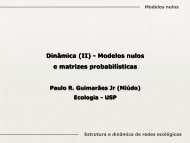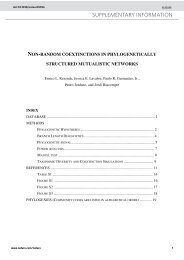Journal of Theoretical Biology 245 - Paulo R. Guimarães Jr.
Journal of Theoretical Biology 245 - Paulo R. Guimarães Jr.
Journal of Theoretical Biology 245 - Paulo R. Guimarães Jr.
- No tags were found...
You also want an ePaper? Increase the reach of your titles
YUMPU automatically turns print PDFs into web optimized ePapers that Google loves.
ARTICLE IN PRESS<strong>Journal</strong> <strong>of</strong> <strong>Theoretical</strong> <strong>Biology</strong> <strong>245</strong> (2007) 784–789Letter to Editorwww.elsevier.com/locate/yjtbiInvestigating small fish schools: Selection <strong>of</strong> school—formation models by means <strong>of</strong> general linear models andnumerical simulations1. IntroductionThe aggregation <strong>of</strong> organisms is a ubiquitous biologicalphenomenon that occurs in a wide range <strong>of</strong> species, frombacteria to large vertebrates, and across a range <strong>of</strong>temporal stability, from ephemeral reproductive assemblagesto obligatory schools or herds (Allee, 1933). Ingeneral, the processes that lead to the aggregation <strong>of</strong>individuals are driven by a complex interplay betweenhabitat characteristics and individual behaviour. Toillustrate the importance <strong>of</strong> individual behaviour, we notethat a number <strong>of</strong> studies have suggested that importantfeatures <strong>of</strong> aggregations, such as size, shape, and architecture,emerge as a consequence <strong>of</strong> simple behaviouralrules that govern the interactions among individuals(Parrish and Edelstein-Keshet, 1999; Niwa, 2005). Understandingaggregation therefore always entails identifyingthe behavioural rules that generate the observed patterns inanimal aggregations.Aggregation size, usually defined as the number <strong>of</strong>individuals that are part <strong>of</strong> an aggregation, has receivedconsiderable attention, especially in the characterizationand prediction <strong>of</strong> the observed variation in school size infish species (Bonabeau et al., 1999; Bonabeau and Dagorn,1995; Niwa, 1996, 1998, 2003, 2004). Most <strong>of</strong> these studieshave noted that the probability <strong>of</strong> finding a large schooldecays as flat-tailed distributions such as power-laws andpower-laws with an exponential truncation for large schoolsize (Bonabeau and Dagorn, 1995), although exponentialdistributions have also been recorded (see Niwa, 2003).Flat-tailed distributions are relevant because they characterizestatistical properties associated with differentecological systems such as mutualistic networks (Jordanoet al., 2003) and ecological communities (Hubbell, 2001).The characterization <strong>of</strong> school-size distributions aspower-laws, truncated power-laws or exponentials <strong>of</strong>tenfocuses on fish species such as the tuna (e.g. Niwa, 2003),for which schools are very large (<strong>of</strong> the order <strong>of</strong> severalhundred individuals), thereby allowing a precise statisticalcharacterization <strong>of</strong> school-size distribution. However,many fish species do not form large schools. On thecontrary, some fishes aggregate forming small schools, inwhich the number <strong>of</strong> individuals is seldom larger than a fewdozens. In such cases, the characterization <strong>of</strong> school-sizedistribution lacks statistical confidence and, as a consequence,the study <strong>of</strong> the organizing principles <strong>of</strong> schoolformation has been limited to fishes that aggregate in largeschools (e.g. Bonabeau and Dagorn, 1995; Niwa, 2003;Powers, 2004). Statistical procedures that allow the study<strong>of</strong> fish schools with few individuals will allow theinvestigation <strong>of</strong> the organization <strong>of</strong> schools <strong>of</strong> many fishspecies and will be also important in a broader sense. Asrecently noted by Amaral et al. (2004) in the context <strong>of</strong>web-like systems, the characterization <strong>of</strong> the structure <strong>of</strong>natural systems containing small number <strong>of</strong> elements is one<strong>of</strong> the main challenges in the study <strong>of</strong> complex systems (seealso Guimara˜es et al., 2005).Here we explore a possible solution for the characterization<strong>of</strong> low dimensional systems using as reference systemthe Southwest Atlantic parrotfish Sparisoma axillare(Perciformes: Scaridae), which forms small schools atfeeding sites. We combine general linear models andsimulations to describe the functional form <strong>of</strong> school-sizedistribution and select between two recently proposedschool-formation models (Powers, 2004). We demonstratedthat the proposed characterization allows the selectionamong candidate models even for species in which schoolsizes are <strong>of</strong>ten small.2. Material and methods2.1. Reference systemThe study site consisted <strong>of</strong> sandy areas adjacent to therocky shore <strong>of</strong> the Praia da Conceic-a˜o, at Fernando deNoronha archipelago ð03 50 0 S; 32 25 0 WÞ, about 345 km <strong>of</strong>fnortheast Brazil (see Carleton and Olson, 1999 fordescription <strong>of</strong> the archipelago), from May to June 2003.During the study, horizontal visibility was 20 m, whichallowed adequate observation <strong>of</strong> fish schools. The watertemperature was 27 C and the depth <strong>of</strong> the study siteranged 2–7 m. The observations were done by divingduring daylight hours, from 0900 to 1700 h in five nonconsecutivedays while snorkelling. No nocturnal observationswere made since parrotfishes are inactive at night(Starck and Davis, 1966).Parrotfishes are bottom-foragers, feeding mostly onalgae and dead coral (Bruggemann et al., 1994a, b). Theparrotfish S. axillare is endemic to the tropical and0022-5193/$ - see front matter r 2006 Elsevier Ltd. All rights reserved.doi:10.1016/j.jtbi.2006.12.001
ARTICLE IN PRESSLetter to Editor / <strong>Journal</strong> <strong>of</strong> <strong>Theoretical</strong> <strong>Biology</strong> <strong>245</strong> (2007) 784–789 785subtropical Southwestern Atlantic (Moura et al., 2001).Initial phase individuals <strong>of</strong> S. axillare forage alone or inschools (Bonaldo et al., 2006). At the studied site, the initialphase individuals foraged along the rocky shore and onsand flats. In sand flats, S. axillare gather to forage on thesparse rocks and form near motionless schools (Bonaldoand Krajewski, unpublished results). We assessed theparrotfishes distribution at Praia da Conceic-a˜o with 16transect lines (5 m 100 m) parallel to the rocky shore,where we registered all the numbers <strong>of</strong> initial phaseindividual S. axillare in each group. The good observationconditions and the spatial homogeneity <strong>of</strong> sand flatssuggest that our sample is representative. During ourfieldwork, the schools observed were <strong>of</strong>ten small, thelargest having up to 20 fish.2.2. Characterizing the school-size distributionThe number <strong>of</strong> schools recorded for each school sizeformed the school-size distribution. In these analyses,solitary fish were recorded as 1-fish schools. We used theformalism <strong>of</strong> general linear models (McCulloch and Searle,2000) to assess whether the observed school-size distribution<strong>of</strong> S. axillare could be characterized as an exponentialor a power-law. Initially, we recall that both exponentials,y / e b 1k , and power-laws, y / k b 2, can be written as linearmodels, respectively, as logðyÞ ¼a 1 þ b 1 k þ e and logðyÞ ¼a 2 þ b 2 log k þ e, where a 1 and a 2 are the fitted normalizationconstants, b 1 , and b 2 are the fitted slope constants,k is the school-size, y is the number <strong>of</strong> recorded schoolswith a given school-size (kÞ, and e is the error. If theobserved school-size distribution is described by anexponential, we would expect b 1 k to be significant, whereasif a power-law adequately describes the data set, we wouldexpect b 2 log k to be significant. If both b 1 k and b 2 log kare statistically significant then school-size distribution canbe described by either an exponential or a power-law. Ifneither term is significant, the observed distribution cannotbe described by either an exponential or a power-law.2.3. School-formation modelsRecently, different types <strong>of</strong> splitting/coalescing modelswere proposed to explain school-size distributions (Bonabeauet al., 1999; Bonabeau and Dagorn, 1995; Niwa 1996,1998, 2003). However, the assumptions <strong>of</strong> splitting andcoalescing do not adequately describe the natural history <strong>of</strong>S. axillare because these fishes aggregate at feeding siteswhere they form small groups that may remain nearlymotionless and seldom coalesce with other schools or splitinto new schools (Bonaldo, unpublished results). Singleindividuals may join schools, suggesting that schools mayincrease in size during the feeding period (morning toafternoon). In fact, larger schools were recorded atafternoon (Bonaldo et al., 2006). The two models usedhere are adapted versions <strong>of</strong> the recently proposed modelsinspired in complex networks (Powers, 2004). The twomodels used here assume that: (1) at t ¼ 0 there was asingle 1-fish school in the sand flats; (2) at each timeinterval, a fish moved from the rocky shore to the sandflats; (3) this new individual in the sand flats had a constantprobability, 1 p, <strong>of</strong> joining a school already present, orremained alone, creating a new 1-fish school with probabilityp; (4) if an individual joined a school already in thearea, it could choose among any <strong>of</strong> the fish schoolspresent—this assumption is supported by the spatialhomogeneity <strong>of</strong> sand flats; (5) individuals did not leavethe schools until the end <strong>of</strong> the simulation, and (6)the simulation ends when the number <strong>of</strong> fishes in thesand flats is equal to the observed number <strong>of</strong> fishes in thesand flats. The only difference between the two models washow a fish chooses among the schools already present: thefirst model, referred to as the random (R) model, is basedon the assumption that, if a fish joined a previouslyestablished school, the probability <strong>of</strong> it choosing the ithschool isP ¼ 1 N . (1)In this equation, N is the number <strong>of</strong> previously establishedschools and P is independent <strong>of</strong> school size. In contrast,the second model, referred to as the preferential attachment(PA) model, is based on the assumption that, if thefish joined a school, the probability <strong>of</strong> its choosing amongone <strong>of</strong> the already existing schools is not uniform. Rather,fish have a tendency to preferentially join larger schools.The tendency <strong>of</strong> large schools to be more attractive tosolitary individuals can be modelled using a conceptderived from network theory, the PA rule (Baraba´si andAlbert, 1999), in which the probability P that a fishjoins school i depends on school size, k i , in a linearfunctional formPðk i Þ¼k iPj k . (2)jIn this equation, P j k jis the sum <strong>of</strong> the sizes <strong>of</strong> all schoolsalready present.The few differences between our models and those <strong>of</strong>Powers (2004) are related to particulars <strong>of</strong> the naturalhistory <strong>of</strong> S. axillare. These differences include theassumptions that: (i) there is no recruitment or deathduring simulation. This assumption is reasonable becauseschools <strong>of</strong> S. axillare are temporary since they form atfeeding sites (rocks on sand flats) and (ii) only 1-fishschools aggregate to previous schools. This assumption isbased on naturalistic observations that indicate thatschools seldom aggregate, but solitary fish usually joinschools and remain in the school while feeding (Bonaldo,unpublished results). It is also important to notice that thePA model is similar to the well-known Simon model <strong>of</strong>growing aggregations, which has been used to studyabiotic, biotic and social systems (see Albert and Baraba´si,2002 for further discussion).
786ARTICLE IN PRESSLetter to Editor / <strong>Journal</strong> <strong>of</strong> <strong>Theoretical</strong> <strong>Biology</strong> <strong>245</strong> (2007) 784–7892.4. School-formation model selection and numericalsimulationsThe R and PA models differ in their asymptoticbehaviours: the R model generates exponential distributions,in which all schools have similar sizes, whereas thePA model generates power-law distributions, in which agreat proportion <strong>of</strong> individuals are part <strong>of</strong> a few largeschools and the majority <strong>of</strong> schools are very small(Baraba´si and Albert, 1999; Powers, 2004). In contrast, insystems with a small number <strong>of</strong> component elements, suchas that analysed here, characterization <strong>of</strong> the distributionmay not be so easy (Guimara˜es et al., 2005). Indeed, wefound that the school-size distributions generated by bothmodels at small-size situations can be described by powerlaws(results not shown). To circumvent this problem, weused the estimated slope constant, b i , <strong>of</strong> the significantgeneral linear model rather than the qualitative (‘‘exponential’’or ‘‘power-law’’) description <strong>of</strong> the functionalform, to select between the two models <strong>of</strong> fish aggregation.The ability <strong>of</strong> the models to predict the observed value <strong>of</strong>the slope constant was examined by using simulations togenerate the empirical distribution <strong>of</strong> b i for each model(4000 simulations). We considered that the model reproducedthe field data if the observed value lies within the95% confidence interval <strong>of</strong> the empirical distribution.3. Results and discussionNeotropical parrotfish S. axillare at Fernando deNoronha archipelago <strong>of</strong>ten form small schools (<strong>of</strong>ten o20 individuals). We sampled 65 schools <strong>of</strong> S. axillare,which corresponded to a total <strong>of</strong> 124 individuals ( ¯X SD,¯k ¼ 1:9 3:0 individuals per school). The value <strong>of</strong> ^p wasdirectly estimated from field data, simply by dividing thenumber <strong>of</strong> schools recorded minus one (N 1 ¼ 64Þ, bythe number <strong>of</strong> fish recorded minus one ðn 1 ¼ 123Þ,which yielded ^p ¼ 0:52. To remove first order bias <strong>of</strong> ^p weused jackknife procedures (Davison and Hinkley, 1997),and simulations are performed using the corrected value^p ¼ 0:50. The exponential function did not adequatelydescribe the observed school-size distribution <strong>of</strong> S. axillare(d:f : ¼ 6; R 2 ¼ 0:47; F ¼ 4:46; P ¼ 0:1Þ. In contrast, thepower law distribution generated a good description <strong>of</strong>a0.20.180.160.14Frequency0.120.10.080.060.040.02bFrequency00.160.140.120.10.080.060.040.020-2.5 -2.3 -2.1 -1.9 -1.7 -1.5 -1.3 -1.1 -0.9 -0.7β 2-2.4 -2.2 -2.0 -1.8 -1.6 -1.4 -1.2 -1 -0.8β 2Fig. 1. The empirical distribution <strong>of</strong> b 2 generated by: (a) the R model and (b) the PA model. The dashed lines indicate the lower and upper limits <strong>of</strong> the95% confidence interval. The black arrow indicates the observed value for Sparisoma axillare.
ARTICLE IN PRESSLetter to Editor / <strong>Journal</strong> <strong>of</strong> <strong>Theoretical</strong> <strong>Biology</strong> <strong>245</strong> (2007) 784–789 787the school-size distribution <strong>of</strong> this species. The estimated The solution <strong>of</strong> the above equation isqk iqt ¼ m k iP N 1j¼1 k ¼ m k ij2mt ¼ k analytic prediction resulted from the small number <strong>of</strong> fishes.i2t . (3) These results reinforce the importance <strong>of</strong> the introducedapproach for the study <strong>of</strong> small complex systems.value <strong>of</strong> the slope constant was b 2 ¼ 1:21 and the linear model log y ¼ 2:99 1:21 log k was highly significant k i ¼ mt a(d:f : ¼ 6; R 2 ¼ 0:80; F ¼ 20:25, Po0:01Þ. Therefore, wet i(4)used b 2 in the procedure <strong>of</strong> model selection.in which a ¼ 1Although the schools are small, the organization <strong>of</strong> these2. The predicted exponent for the probability<strong>of</strong> a node showing k links derived from (4) is bschools is not random. The average b 2 predicted by the R2 ¼1=a 1 ¼ 3 (Albert and Baraba´si, 2002). In the PAmodel was lower than the observed b 2 ¼ 1:21 formodel for fish schools, the probability that the size <strong>of</strong> theS. axillare (Fig. 1a). In contrast, the empirical distributionschool i increases with time is slightly different from (3),generated by the PA model reproduced the observed b 2 depending on pfor S. axillare (Fig. 1b). Therefore, our analysis suggeststhat the model that assumes that fishes preferentially join qk ilarger schools reproduces the features <strong>of</strong> the school-size qt ¼ð1 pÞ k iP N 1j¼1distribution.¼ð1 pÞ k ijt . (5)We also note that the exponent generated by the Therefore, a ¼ð1 pÞ and the predicted exponent isnumerical simulations <strong>of</strong> the PA model is very different b 2 ¼½ 1=ð1 pÞŠ 1. In the case <strong>of</strong> the studied parrotfishes,from the analytic prediction <strong>of</strong> the original network model p ¼ 0:5 and, consequently, the above analytic approach(Baraba´si and Albert, 1999). In complex networks, PA predicts b 2 ¼ 3. Additional numerical simulations demonstratepredicts that the degree (kÞ <strong>of</strong> the node i varies with timefollowing the dynamical equation:that the analytic predictions are valid for large systems(Fig. 2). Therefore, the differences between the result <strong>of</strong>numerical simulations based on the reference system and theaSchool-size1 10 100 1000 100000.1Frequency0.010.001b0.00011School-size1 10 100 1000 100000.1Frequency0.010.0010.0001Fig. 2. (a) Agreement between numerical simulations and analytic predictions (lines) for large systems (n ¼ 10 000 fishes) for preferential attachmentmodel. School-size distributions were plotted as cumulative distributions to reduce finite-size fluctuations (Strogatz 2001): p ¼ 0:10 (circles), p ¼ 0:25(squares), and p ¼ 0:5 (triangles); (b) school-size distributions generated by numerical simulations using random attachment are plotted for comparisons.
ARTICLE IN PRESSLetter to Editor / <strong>Journal</strong> <strong>of</strong> <strong>Theoretical</strong> <strong>Biology</strong> <strong>245</strong> (2007) 784–789 789Niwa, H.S., 2004. Space-irrelevant scaling law for fish school sizes.J. Theor. Biol. 228, 347–357.Niwa, H.S., 2005. Power-law scaling in dimension-to-biomass relationship<strong>of</strong> fish schools. J. Theor. Biol. 235, 419–430.Parrish, J.K., Edelstein-Keshet, L., 1999. Complexity, pattern, andevolutionary trade-<strong>of</strong>fs in animal aggregation. Science 284,99–101.Powers, J.E., 2004. Recruitment as an evolving random process <strong>of</strong>aggregation and mortality. Fish. Bull. 102, 349–365.Starck, A.S., Davis, W.P., 1966. Night habits <strong>of</strong> fishes <strong>of</strong> Alligator Reef,Florida. Ichthyologica. 38, 315–356.Strogatz, S.H., 2001. Exploring complex networks. Nature 410,268–276.<strong>Paulo</strong>. R. Guimara˜es <strong>Jr</strong>.Departamento de Física da Matéria Condensada,Instituto de Física Gleb Wataghin,UNICAMP, 13083-970, Campinas, SP, BrazilandIntegrative Ecology Group, Estación Biológica de Doñana,CSIC, Apdo. 1056, E–41080 Sevilla, SpainE-mail address: prguima@ifi.unicamp.brRoberta M. BonaldoJoa˜o P. KrajewskiPrograma de Pós-Graduac-ão em Ecologia,Instituto de Biologia, UNICAMP, 13083–970,Campinas, SP, BrazilE-mail addresses: robertabonaldo@yahoo.com(R.M. Bonaldo),jpaulokra@yahoo.com.br (J.P. Krajewski)<strong>Paulo</strong> Guimara˜esDaitan Labs, Galleria Office,Bloco 4, cj 444, Campinas, SP, BrazilE-mail address: prguima.pm@gmail.comAluı´sio PinheiroDepartamento de Estatística, Instituto de Matemática,Estatística e Ciência da Computac-ão, UNICAMP,13083–970, Campinas, SP, BrazilE-mail address: pinheiro@ime.unicamp.brJoseph Powers2147 Energy, Coast and the Environment Building,School <strong>of</strong> Coast and Environment,Louisiana State University, Baton Rouge,LA 70803, USAE-mail address: jepowers@lsu.eduSe´rgio Furtado dos ReisDepartamento de Parasitologia, Instituto de Biologia,UNICAMP, 13083–970, Campinas, SP, BrazilE-mail address: sfreis@unicamp.br





